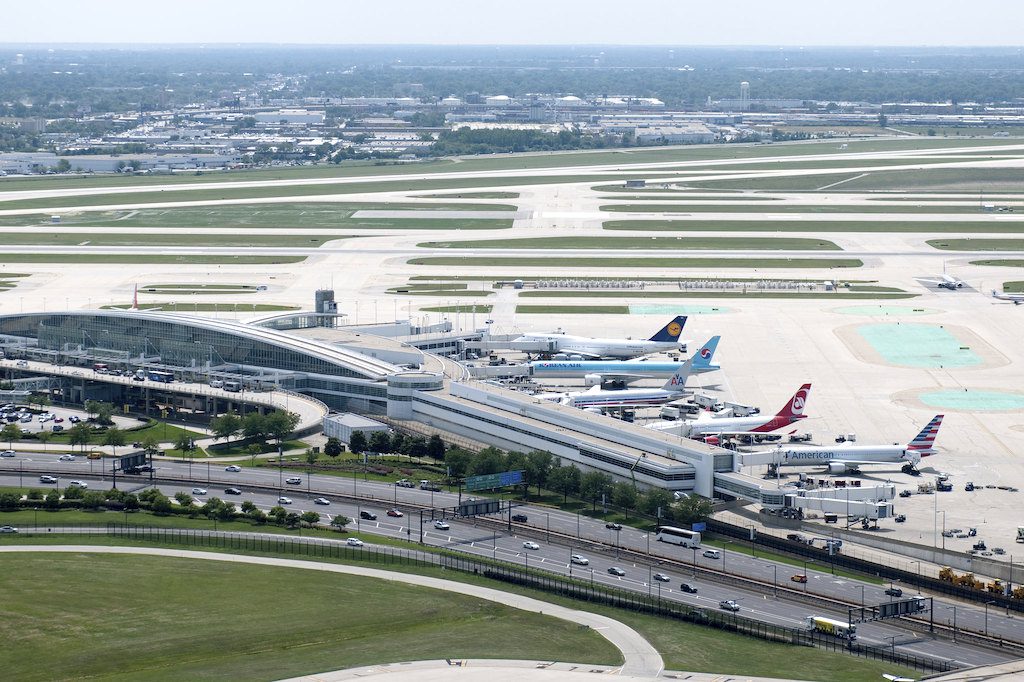
Chicago’s O’Hare International Airport, whose Terminal 5 Airfield is pictured here, was one of several U.S. airports that Emirates resumed flights to after temporarily suspending flights to some U.S. destinations amid the deployment of 5G C-Band services. (Chicago Department of Aviation)
The Federal Aviation Administration (FAA) on Thursday published a statement to allow an estimated 78 percent of the in-service U.S. commercial fleet to perform low-visibility landings at airports where wireless companies deployed 5G C-band, giving several U.S. and international airlines the ability to restore some flights that were cancelled due to AT&T and Verizon flipping the switch on their new networks on Jan. 19.
Thursday’s update from the FAA followed an agreement reached by the aviation and telecommunications industry on Tuesday when AT&T and Verizon both agreed to temporarily delay turning on a limited number of the 5G C-Band towers that they’re deploying near certain airports. Since the beginning of December, the two sides of the 5G C-Band deployment have agreed to several delays and risk mitigation measures for the 5G towers being deployed to ensure aircraft radar and radio altimeter signals do not experience interference from the new wireless network services that are being deployed.
According to the statement published Thursday by the FAA, airplane models that feature one of 13 “cleared altimeters” that the agency has determined are safe from potential 5G C-Band interference include “all Boeing 717, 737, 747, 757, 767, 777, 787, MD-10/-11; all Airbus A300, A310, A319, A320, A330, A340, A350 and A380 models; and some Embraer 170 and 190 regional jets.”
FAA officials are anticipating some altimeters will be too susceptible to potential 5G interference and the aircraft they’re featured on will be prohibited from performing low-visibility landings where 5G C-Band is deployed because the altimeter could provide inaccurate information. Aircraft radar altimeters operate within 4.2–4.4 GHz, the lower half of which falls within the C-Band—a frequency range from 3.7–4.2 GHz where the combination of the range of signal transmissions and capacity are optimum.
The 5G wireless networks that were switched on by AT&T and Verizon this week operate within the 3.7–3.98 GHz frequency range, close to the altimeters, which has left aviation industry experts with concerns over signal interference issues. In December, the FAA published new airworthiness directives (ADs) that will prohibit certain types of advanced fixed and rotary wing landing procedures that rely on the use of radar altimeter data.
Verizon, in a Jan. 19 statement published to its website said that it has “voluntarily decided to limit our 5G network around airports. The Federal Aviation Administration (FAA) and our nation’s airlines have not been able to fully resolve navigating 5G around airports, despite it being safe and fully operational in more than 40 other countries.” This latest voluntary agreement, which AT&T has also committed to, is in addition to the six-month period during which the two companies have already stated they will limit the power radiated from 5G base stations located near airports.
“Following a 6-week voluntary pause and the implementation of additional precautionary measures to allow the Federal Aviation Administration and aviation industry to complete evaluations, today’s introduction of C-Band spectrum begins turbo-boosting our 5G wireless service with our newest AT&T 5G+ service,” AT&T said in a Jan. 19 statement.
Several U.S. and international airlines adjusted flight operations this week as the FAA continues its work determining which aircraft altimeters are too susceptible to 5G C-Band interference to allow them to operate low visibility landings at certain airports. The FAA on Jan. 7 published a new list of the 50 U.S. airports that will have “buffer zones” around them to further mitigate against the risk of potential 5G C-Band altimeter signal interference.
Emirates is reinstating its Boeing 777 operations to Chicago, Dallas Fort Worth, Miami, Newark, Orlando and Seattle as a result of the FAA’s latest update clearing altimeters featured on nearly 80% of the in-service U.S. commercial fleet, according to a Jan. 20 statement published by the Middle Eastern carrier. Earlier this week, Emirates suspended its services to some US destinations based on the FAA advisory and recommendations from Boeing on possible interference between the 5G antennas and aircraft altimeters.
“We apologize for the inconvenience caused to our customers by the temporary suspension of flights to some of our US destinations. Safety will always be our top priority, and we will never gamble on this front,” Sir Tim Clark, President, Emirates Airline said in a statement. “We welcome the latest development which enables us to resume essential transport links to the US to serve travelers and cargo shippers. However, we are also very aware that this is a temporary reprieve, and a long-term resolution would be required. Emirates will continue to work closely with the aircraft manufacturers and relevant regulators to ensure the safety and continuity of our services.”
When asked about the 5G C-Band deployment issues during a Jan. 20 earnings call, outgoing American Airlines CEO Doug Parker said that the airline does not anticipate “any material disruption” as long a the latest voluntarily agreements from AT&T and Verizon remain in place. Incoming Southwest Airlines CEO Bob Jordan shared an update with the regional carrier’s employees on Jan. 19 that was also welcoming to the agreements undertaken by AT&T and Verizon as well.
Jordan said that the two companies only recently released all of the data necessary for aircraft manufacturers to perform safety tests. “This means the right parties haven’t had the time needed to study potential 5G interference with aircraft equipment and to develop extensive mitigation plans that would prevent disruptions,” he said. “Now, my hope is that this pause in 5G expansion grants the FAA more time to evaluate the data for specific airports and runways so that 5G cellular service and airline operations can safely coexist, as it shouldn’t be a one-or-the-other proposition.”